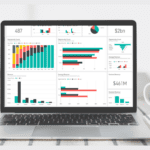Using Data to Create a Competitive Advantage
As we outlined in What is ‘Big Data’; and why is it such a big deal?, effective analysis of large volumes of data can identify new opportunities, products and services, and result in significant cost savings and operational improvements.
“To paraphrase the Rime of the Ancient Mariner by Samuel Taylor Coleridge, we frequently see cases of ‘Data, data, every where, Nor any drop to drink’,” said Jeff Robson, Access Analytic Principal Business Analyst.
“The fact is, there are very few business analysts who understand both the business and business issues – and the analytics required to add value and extract relevant information from large pools of data,” said Jeff.
However, a 2013 survey found that:
67 per cent of surveyed companies were gaining a competitive advantage from analytics – up from 58 per cent in 2012 and just 37 per cent in 2015.
Analytics is often also misunderstood within organisations, and seen as a threat by many senior managers. Descriptive analytics seeks to understand past data, and is widely used.
However, prescriptive analytics tries to identify what a business should do. This can be a major challenge when the directions analysis suggests conflict with management intuition.
In progressive organisations, this threat is overcome relatively easily.
“At its best, effective analytics informs decision makers, leading to better decisions,” said Jeff Robson.
“Once management accepts that prescriptive analytics does not ‘make decisions’ itself, but helps intelligent, knowledgeable and highly experienced people make better decisions, the organisation is on the road to really creating a competitive advantage from big data.
“However, this requires both the data itself, and the skills of the analytics professional.”
What data do you currently have available?
You may well be surprised. Many organisations already have a significant amount of information captured, but may typically have much more that is not yet captured in a digital, easily accessible or searchable form.
In addition, as organisations create and store more transactional data, they can collect more accurate and detailed information on everything from product inventories to sick days and use it to expose variability and boost performance.
Today, ever narrower customer segmentation is vital to delivering more accurately tailored products and services. All customer data is valuable, and your business intelligence approach should make continually improving and refining its collection a priority.
Increasingly, companies are also turning to third party data sources, such as business partners or customers, and integrating this information with their own.
What should you be doing to maximise the value of all that data?
PricewaterhouseCoopers’ (PwC) 5th Annual Digital IQ Survey of more than 1,100 business and technology executives in February 2013 found that 62 per cent of respondents believe that big data can deliver a competitive advantage. However, 58 per cent agreed that moving from data to insight is a major challenge.
Apart from the philosophical management issues discussed earlier, the second hurdle to effective big data analytics Jeff Robson often sees is technology.
“Legacy systems and incompatible formats and standards often prevent effective data integration and therefore, hinder the application of more sophisticated analytics that can create real value and sustainable competitive advantage,” said Jeff.
To validate Jeff’s statement, almost half of the PwC survey respondents in the Asia-Pacific region agree that their current information technology systems are unable to process large volumes of data from different sources.
The answer to how to turn data into competitive advantage, says Jeff Robson; is technology.
“Microsoft Power BI is a valuable tool that Access Analytic uses to help business analysts analyse, simulate, model and report on an organisation’s performance in a simple and highly effective manner,” said Jeff.
“Comprising PowerPivot, PowerQuery, and PowerMap, Power BI enables seamless integration of data from different systems and streamlines analysis of the biggest data sets.
Because it is all provided as part of Microsoft Excel, many organisations now already have all the software they need to produce the reports and insights they desire – all they need is some consulting assistance.
“Power BI easily integrates data from different sources and allows the creation of a self-service analysis environment that lets you navigate massive amounts of data from the highest to the lowest level of detail. You can also obtain multi-dimensional views of data and identify and analyse any sub-sets.”
With Power BI, running ‘what-if’ and goal-seeking scenarios is quick and efficient and you can easily build personalised, self-sufficient data analysis systems.
Access Analytic can provide specialist services to quickly develop applications and or train a team on how to use build custom solutions in-house.
To find out more and organise an Access Analytic presentation on how we can turn your data into opportunity and competitive advantage – no matter how Big that task may currently seem – contact Jeff Robson on +618 6210 8500 or jrobson@accessanalytic.com.au.







